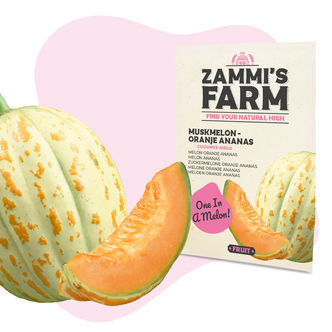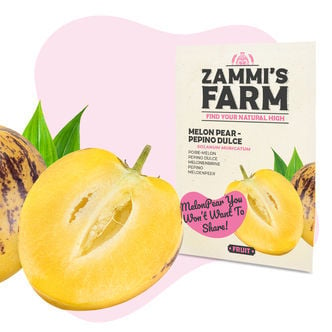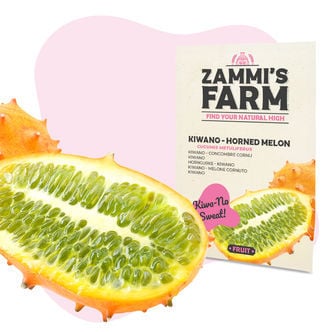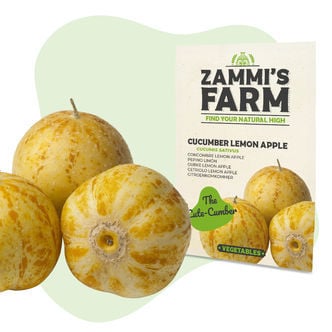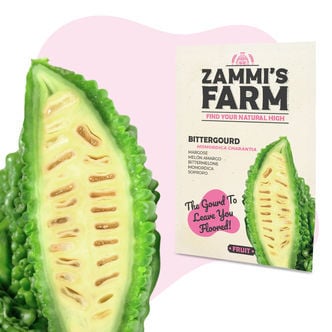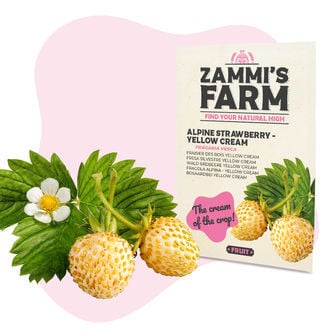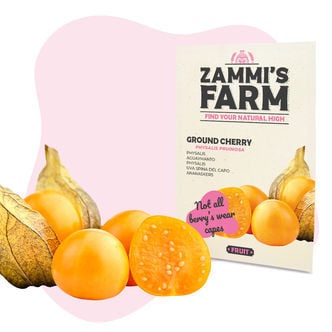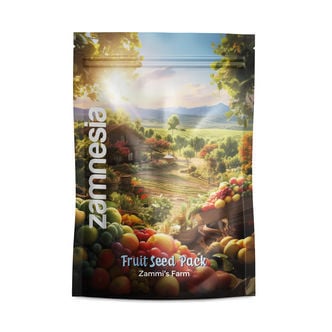Fruit Seeds
Get your fix of the finest fruit seeds available from the Zamnesia Plantshop. While you can visit your local supermarket and buy ready and ripe fruit, where's the fun in that? Believe us when we say that there's nothing as rewarding or satisfying as cultivating your own fruits from home. You also don't need acres of land to do so either! From novices to those with more experience, we've got you covered with our extensive range of fruit seeds. All are available to purchase right now.
Our fruit seeds cater for all kinds of settings and environments. Regardless of whether you have plenty of space in your garden or want to grow a few plants on your balcony, these fruit seeds work with you, not against you. So browse our selection, take your picks, and enjoy fresh and tasty fruit whenever you'd like!
Alpine Strawberry (Fragaria vesca) Seeds
Alpine strawberry (Fragaria vesca) loves full sun or partial shade, though it's best to protect plants from the afternoon sun in hot climates. While Fragaria vesca can tolerate some shade, plants produce more fruit in bright, sunny locations. Grow Fragaria vesca in well-draining, fertile, and moist soil. Alpine strawberries have a strong flavour and can be enjoyed fresh or made into...
Muskmelon 'Oranje Ananas' (Cucumis melo) Seeds
Sow muskmelon seeds outdoors after the last frost in full sun and moist, well-draining soil. Make sure to keep the soil moist (but not wet) at all times for proper germination. Space plants at least 30cm apart, and consider sowing multiple seeds in each spot and thinning the plants once seedlings emerge. Harvest fruits when their skin changes colour and they smell ripe and aromatic.
Melon 'Charentais' (Cucumis melo) Seeds
Fresh, sweet and perfect for breakfast, or well, anytime of the day, to be honest! Melon Charentais makes for a great growing project that yields some fruitful rewards. Start your seeds in a greenhouse or indoors, and then transplant them outdoors for the sunny summer months. Keep them well-watered, and they'll be happy for their entire growing cycle. Just try not to eat them all at once!
Watermelon 'Crimson Sweet' (Citrullus lanatus) Seeds
The classic watermelon is perfect for enjoying at any time. Fresh and sweet, it goes great with breakfast or a post-dinner fruit salad. Now you can grow your own from the comfort of your home. While they can be a little tricky for newcomers, experienced gardeners will find them a breeze. Start them under glass in March/April, and they'll flourish over the summer. Harvest from July to...
Melon Pear (Solanum muricatum) Seeds
Melon Pear (Solanum muricatum), commonly called Pepino Dulce (sweet cucumber in Spanish), is a shrub native to South America. It produces sweet fruit with the looks and texture of a melon and a succulent flavour similar to honeydew. Melon Pear is super easy to grow, thriving in temperate climates, full sun, and rich soil with a neutral PH. Harvest when the fruit develops purple streaks.
Horned Melon (Cucumis metuliferus) Seeds
Looks can be deceiving with this prickly fruit. It might look a little intimidating, but it's what's inside that counts. The Kiwano houses a sweet taste that's reminiscent of lemons and bananas. Perfect for fruit salads and desserts. Start your plants out in a greenhouse and then place them outside for full sun. A little hands-on grow-wise but manageable, it needs a warm climate or...
Lemon Apple Cucumber (Cucumis sativus) Seeds
Perfect for salads, the lemon apple cucumber has a slightly sweet flavour that's refreshing and moreish. All it takes is a little gardening know-how, and you'll have some fantastic fruits at your disposal. Get the seeds started under glass, and allow the plants to flourish until late summer. Then, you can harvest and enjoy the yellow, apple-shaped fruits of your labour. Delicious!
Bitter Gourd (Momordica charantia) Seeds
The bitter gourd, otherwise known as bitter melon or balsam pear, is a fruit that originally comes from Africa and Asia. However, now you can grow it right at home! Start it off in a greenhouse or indoors for 4 weeks, then move it outdoors to flourish in the summer months. Typically, it'll be ready to harvest come October. Pair it with fish or meat, and you simply can't go wrong.
Alpine Strawberry - Yellow Cream (Fragaria vesca) Seeds
Easy to look after, Alpine Strawberry prefers sunny balconies, windowsills or garden beds. Germinate indoors. Scatter your seeds on the surface of the soil as they need light. Lightly cover with soil and keep moist with a spray bottle. Seeds need 3–4 weeks to sprout and once they have 4 leaves, they can be transplanted into rich soil and placed outside. Expect fruit same or following year.
Grandian Strawberry F1 (Fragaria x ananassa) Seeds
Few things are as rewarding as picking your own strawberries. These Granadian F1 strawberries produce large, plump, and deliciously sweet fruits. Start them off early in a protected seedbed when temperatures reach 20°C and transplant them into large pots or an open field in early summer. Pick your berries when they're plump and red, and resow your seeds every year.
Kiwi (Actinidia deliciosa) Seeds
Germinate seeds in a clear ziplock bag on a damp paper towel. Keep in a warm place until seeds sprout (2 weeks approx.), then put into small pots. Seedlings like a warm, sunny environment and slightly acidic soil. After 3–4 months they can be transplanted into bigger pots or garden beds outside. Kiwi is a vine, so prepare to train and support plants as they grow. Plants bear fruit after 4–6...
Ground Cherry (Physalis peruviana) Seeds
Also known as the Cape gooseberry, Ph. peruviana is native to Chile and Peru, where it is commonly called aguaymanto, uvilla, or uchuva. A member of the Nightshade family, the Ground Cherry produces sweet fruits in a papery husk. Propagate these seeds indoors in early spring, then bring plants outside in early summer. Their fruit is ripe once it falls from the plant and can be eaten raw.
Fruit Seed Pack - Zammi's Farm
This variety pack of fruit seeds gives you the opportunity to grow a range of succulent and refreshing fruit in your very own garden. These fruits will keep your palate excited and your body packed with beneficial nutrients! And the plants themselves will decorate your garden with the diverse splendour of a range of fruits from across the world.
Hanging Strawberries (Fragaria x ananassa) Seeds
Fragaria x ananassa is a variety of strawberry that produces long tendrils and beautiful cascades of red, fragrant fruit. Plant seeds in hanging baskets, raised beds, or boxes in fertile soil, and position in a sunny spot. Press seeds slightly with your hand into the soil. Keep plants well-watered, soaking the ground thoroughly every 2–3 days, taking rainfall and temperature into...








 United States
United States

